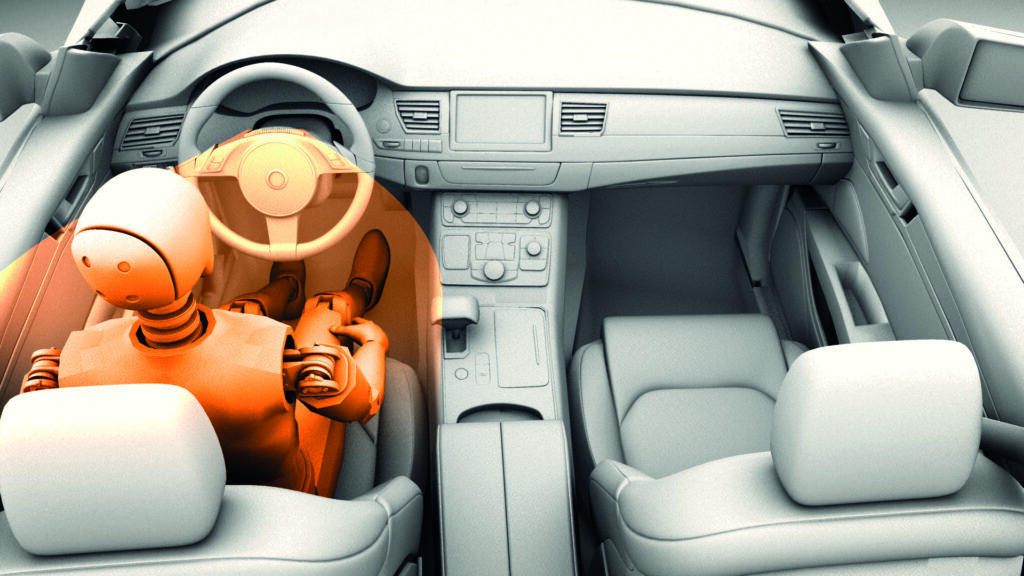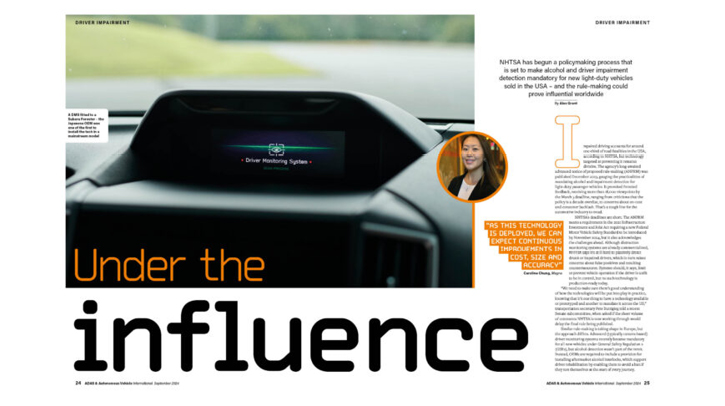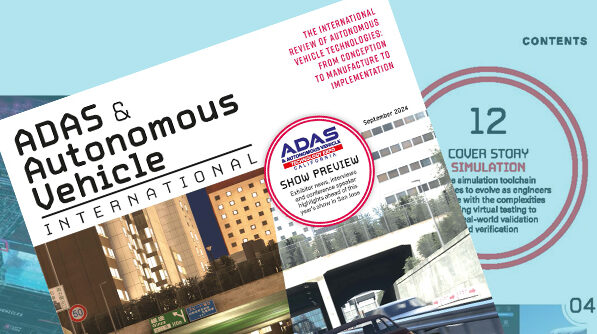NHTSA has begun a policymaking process that is set to make alcohol and driver impairment detection mandatory for new light-duty vehicles sold in the USA – and the rule-making could prove influential worldwide, reports Alex Grant in the September 2024 issue of ADAS & Autonomous Vehicle Technology International.
Impaired driving accounts for around one-third of road fatalities in the USA, according to NHTSA, but technology targeted at preventing it remains divisive. The agency’s long-awaited advanced notice of proposed rule-making (ANPRM) was published December 2023, gauging the practicalities of mandating alcohol and impairment detection for light-duty passenger vehicles. It provoked frenzied feedback, receiving more than 18,000 viewpoints by the March 5 deadline, ranging from criticisms that the policy is a decade overdue, to concerns about on-cost and consumer backlash. That’s a tough line for the automotive industry to tread.
NHTSA’s deadlines are short. The ANPRM meets a requirement in the 2021 Infrastructure Investment and Jobs Act requiring a new Federal Motor Vehicle Safety Standard to be introduced by November 2024, but it also acknowledges the challenges ahead. Although distraction monitoring systems are already commercialized, NHTSA says it’s still hard to passively detect drunk or impaired drivers, which in turn raises concerns about false positives and resulting countermeasures. Systems should, it says, limit or prevent vehicle operation if the driver is unfit to be in control, but no such technology is production-ready today.
“We need to make sure there’s good understanding of how the technologies will be put into play in practice, knowing that it’s one thing to have a technology available or prototyped and another to mandate it across the US,” transportation secretary Pete Buttigieg told a recent Senate subcommittee, when asked if the sheer volumenof comments NHTSA is now working through would delay the final rule being published.
Similar rule-making is taking shape in Europe, but the approach differs. Advanced (typically camera-based) driver monitoring systems recently became mandatory for all new vehicles under General Safety Regulation 2 (GSR2), but alcohol detection wasn’t part of the remit. Instead, OEMs are required to include a provision for installing aftermarket alcohol interlocks, which support driver rehabilitation by enabling them to avoid a ban if they test themselves at the start of every journey.
Dudley Curtis, communications manager at the European Transport Safety Council, says these programs have proved effective, adding that the next stage of regulations should closely observe how solutions are developing.
He explains, “A number of technologies that are less intrusive [than alcohol interlocks] are in development and could either be effective at detecting alcohol in ambient air, or can detect impairment of the driver using camera monitoring. We hope the European Commission will take these developments into account when reviewing EU vehicle safety standards in the 2027-2029 timeframe.”
Passive approach
NHTSA is supporting stakeholders with the development of passive systems. Founded in 2008, the Driver Alcohol Detection System for Safety (DADSS) is a public-private partnership with the Automotive Coalition for Traffic Safety (ACTS), focused on advanced and test prototype-stage solutions. The project is namechecked in the ANPRM, which notes that it has demonstrated technologies that provide consistent, reproducible alcohol measurement that correlates with traditional methods.
Work is ongoing, with recent developments including a collaboration between Magna and Senseair unveiled at the January 2024 Consumer Electronics Show in Las Vegas, Nevada. This augments a traditional driver monitoring camera with another that measures how cabin air absorbs infrared light. Absorption differs between alcohol and CO2, and Senseair claims a detection accuracy of 0.0003mg/l without the driver actively conducting a breath test.
Caroline Chung, engineering manager of interior sensing systems at Magna, says the system has reached a maturity level where it could be deployed in vehicles: “The high level of resolution ensures accurate and reliable alcohol sensing. As this technology is deployed, we can expect continuous improvements in cost, size and accuracy, making it even more effective and accessible in the future.”
However, John Noble, SVP of innovation at Seeing Machines, stresses that regulations should take a more holistic view of intoxication. The company’s ANPRM feedback advocated a three-phase roadmap, starting with mandatory distraction and drowsiness detection, then expanding capability to include alcohol impairment and finally introducing interventions. Despite advances in driver monitoring systems (DMS), accurate alcohol detection remains challenging, especially at the start of the journey, and typically requires additional hardware, he says.
“DMS would be a more natural choice for alcohol impairment detection, because they are already being integrated into cars and represent a key component of future in-cabin vehicle systems. OEMs prefer one system that has many uses, and DMS fits this bill,” Noble explains.
“The fact that we can solve distraction now means that there is no reason why NHTSA should not act immediately. Our estimates show that requiring DMS to detect impairment from distraction, drowsiness and alcohol could save more than 12,000 lives each year with a 50% fleet penetration. This would reduce US road fatalities by over 25% and be the most significant advance in vehicle safety since the seatbelt.”
Smart Eye is pursuing a similar roadmap. The company has tested driver-facing cameras on closed tracks, correlating their ability to detect alcohol intoxication with traditional measurements. Founder and CEO Martin Krantz says cameras installed under the driver’s line-of-sight are best for the advanced measurements required, but that differentiating between drowsiness and intoxication is a challenge as the symptoms overlap.
“Current alcohol detection methods are requiring actions from the driver, based on breath analysis, doing spectroscopy with CO2 as a baseline and resulting in an estimation of BAC,” Krantz explains.
“Our approach is to understand the actual behavior of the driver and correlate it to risk – whether based on alcohol or other types of impairment, such as drugs, sudden sickness or medical conditions. This can prompt the car to take action earlier if impairment is detected, and navigate the car to a safe stop or other preventive action deemed necessary.”

Regulatory perspective
Evolving regulations can also learn from the earliest adopters. Yousif Al-Ani, principal engineer for ADAS at Thatcham Research, says first-generation DMS technology has evolved quickly to meet GSR2 requirements, but it will take time to understand the real- world safety benefits. There are opportunities for policymakers in Europe and the USA to learn from one another, and to harmonize, as those effects become clearer.
“This iterative process of evaluation and adjustment will be crucial in ensuring that regulations remain both realistic and effective in enhancing vehicle safety,” he comments, adding that the net should be cast further than the automotive industry.
“Learning from other sectors, particularly those that have successfully implemented similar detection technologies, could provide valuable insights,” he continues. “For example, the healthcare and consumer electronics industries have pioneered the use of non-invasive sensors and biochemical analysis for monitoring various physiological parameters. Adapting such technologies for in-vehicle use poses unique challenges, including ensuring accuracy and reliability in the dynamic and variable environment of a moving vehicle.”
Rule-making also needs to consider how interventions are handled, as David Zuby, IIHS senior VP of vehicle research, explains, as this is vital for building trust in the technology. He highlights early lane-keeping systems – which tended to scold drivers for not using turn signals and were often ignored or deactivated as a result – as an example. Drivers can also be under the legal blood alcohol content (BAC) limit (0.08%) but still be impaired, he says.
“A complication comes from trying to figure out an intervention that is effective at reducing the risk of crashing due to somebody who’s impaired at 0.06% or 0.07% [BAC]. Are they going to take the advice of a car system that says, ‘Hey, I’ve determined you’re drunk, and I think you should pull over’, or are they going to continue to drive anyway?” he comments.
“Depending on how NHTSA works to specify the requirements, you may create false positives. Most of them are going to be people who are already impaired and are near 0.08% but under 0.08%. Depending on how the regulation is defined, that may count as not meeting the requirements, if the system is calling people under 0.08% as being over [the limit].”
Zuby suggests that systems could follow Volvo’s approach, focusing less on why drivers are impaired and more on how to intervene if they are. The EX90 electric SUV will be the car maker’s first model capable of autonomously triggering its hazard warning lights and navigating itself to a safe stop at the side of the road if the driver is intoxicated or distracted and not responding to warning signals.
“The risk that these systems would detect somebody who’s completely not impaired as impaired is fairly low, but it’s not zero. In crafting regulations and regulatory requirements, I think NHTSA needs to consider what the science says about the precision of the different technologies. That will evolve over time,” he adds.

Consumer view
In the meantime, consumers are cautious. A recent survey by the Future of Privacy Forum found accuracy ranked as the top concern for alcohol and impairment detection (60% and 59% respectively), followed by privacy (48% and 46% of respondents). The report recommended that NHTSA’s final rule should prioritize anonymization, include standards (ensuring they are unbiased) and ensure end users are aware of how information is used. Data collection should be minimal, easily accessed and deleted, and secure: the system should not function as an onboard police officer.
Smart Eye’s Krantz agrees: “Ensuring that collected data is used solely for safety purposes and not for punitive actions will help build consumer trust,” he comments. “Open communication about the benefits and safeguards of impairment detection systems is crucial for gaining public acceptance. The ongoing advances in impairment detection technologies and the regulatory landscape present both challenges and opportunities.”
Those ground rules will shape how systems are developed, as IIHS’s Zuby adds. Consumers might agree with a need for alcohol and impairment detection technology in future vehicles, but it isn’t a selling point yet, he says. The incoming final rule will be important for accelerating their route to market.
“In our comments on the ANPRM, we told NHTSA, ‘You have to tell auto makers that they have to do this and how you are going to judge whether or not they’ve done it well enough. Otherwise, they’re not going to invest the effort and the money to take the technology from where it is right now, in the laboratory, into something that’s integrated into the cabin’,” he says.
“Without NHTSA saying, ‘You have to do this’, there really is no incentive for auto makers or suppliers to do that next step of development.”
Drug detection
Although NHTSA acknowledges the importance of drug detection systems, this capability will not be required as part of the final rule. The agency notes that drug use spans prescription and over-the-counter medicines, as well as illegal substances, and the effects on users are more diverse.
For example, tetrahydrocannabinol (THC), the psychoactive substance in marijuana, can show up in urine for a month after use. It accounts for over half of positive drug tests conducted on truck drivers and reported to the US Department of Transportation, while a 2022 NHTSA study found 25.1% of road users who had been injured or killed in accidents also tested positive for THC – compared with 23.1% for alcohol.
IIHS’s David Zuby says this presents challenges for detecting impairment. Unlike alcohol, there is limited consensus about levels of drugs in the body and how they affect driving, and a clear need for consumer mindset change for prescription substances. NHTSA’s final rule could, as
a knock-on effect, enable vehicles to detect this anyway.“A lot of the drugs that impair driving have overlapping effects with alcohol and/or fatigue. [Drowsiness or alcohol detection] systems are going to get at some of the drug-impaired driving problems, just by virtue of the fact that the symptoms kind of overlap,” he says.
Filling those knowledge gaps will remain difficult. Testing the algorithms needed to detect drug-related impairment has ethical, legal and logistical challenges as they require human subjects.
“Such recordings are needed to train the algorithms used for detection, and also to validate their efficacy,” explains Seeing Machines’ John Noble. “A system that claims to detect people who are unfit to drive, due to alcohol, must be tested against a dataset of individuals who were heavily intoxicated while in control of a vehicle. Acting is not sufficient.”
This feature was first published in the September 2024 issue of ADAS & Autonomous Vehicle International magazine – you can find our full magazine archive, here. All magazines are free to read. Read the article in its original format here.



